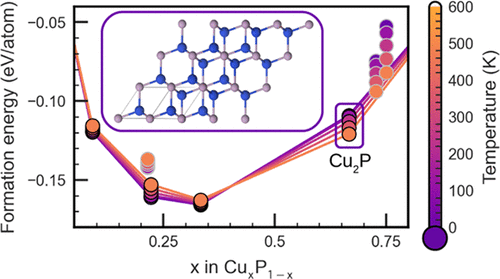Research Highlights
Computational discovery of Cu2P, a new high capacity Li-ion battery anode material
As countries around the world endeavour to meet their 2050 carbon neutral goals, there is an ever-present need for higher capacity batteries which can be used in large-scale energy storage facilities. To this end, a large body of research has attempted to discover and synthesize new battery materials which outperform the commonly used graphite anode, which has a capacity of only 372 mAh/g. In this work, we use Ab Initio Random Structure Searching (AIRSS) combined with a genetic algorithm to identify a novel phase of copper phosphide, Cu2P, which has potentially favorable properties as a Li-ion battery anode.

This study extends previous structure searching work in the group by including finite temperature effects to construct a binary phase diagram for the copper phosphides which extends up to 600 K. This further confirms that the Cu2P phase is stable at and beyond the temperature at which a Li-ion battery would operate. The predicted capacity of Cu2P is 508 mAh/g, with concomitant volume expansion of 99% upon charging, making it a reasonable candidate material for use as a Li-ion battery conversion anode.
All of the work in this paper is available online at GitHub and an interactive version is available to use through Binder.
Computational Investigation of Copper Phosphides as Conversion Anodes for Lithium-Ion BatteriesAngela F. Harper, Matthew L. Evans, and Andrew J. Morris, Chem. Mater. (2020)